

Fine Art Stock Licensing. Details A silk, wool and linen embroidered panel of a man and woman in a garden surrounded by symbols, peacock, for pride, and cockatrice symbolising lust.
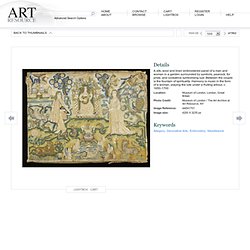
Between the couple is the fountain of spirituality. Harmony is music in the form of a woman, playing the lute under a fruiting arbour, c. 1650-1700 Location: Museum of London, London, Great Britain Photo Credit: Museum of London / The Art Archive at Art Resource, NY Image Reference: Image size: 4200 X 3235 px Keywords. 21382. 21019. 21080. 21874. 21021. 21721. 21857. 21346.
21269. 21879. 21340. 21818. - UCSB English Broadside Ballad Archive. 30563. 30012. The English Emblem Book Project. Word and Image In recent years, scholars in many disciplines have recognized that the literally thousands of engravings, wood blocks, and etchings in emblem books constitute an unparalleled source not only for the study of daily life of the sixteenth and seventeenth centuries but also for extraordinary insights into what the intellectuals of the times viewed as a necessary adjunct to heraldry, social life, politics, philosophy, and moral behavior.
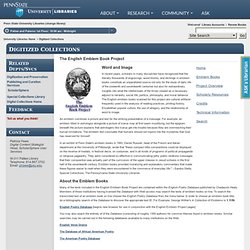
Needlework and SamplersA 17th century stumpwork picture of a lady playing a stringed instrument. A lady, said to be Elizabeth Coombe. Pillow-cover. A fine needlework panel English, 17th Century. British Printed Images to 1700: Home. A 17th century framed stumpwork panel. A 17th Century stumpwork picture of Charles and Henrietta. Lancashire Museums - Understanding the past, inspiring the future - Lancashire County Council. Embroidered casket by Member of the Bourne family - The Art Fund - national fundraising charity for works of art. Hirst-3. High quality reproduction art prints, canvases, postcards, greeting cards. Paula Guisinger's Photos - stitchin fingers. Casket. Object Type Caskets like this were used by girls in the 17th century for storing small personal possessions.
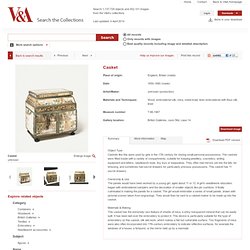
The caskets were fitted inside with a variety of compartments, suitable for keeping jewellery, cosmetics, writing equipment and letters, needlework tools, tiny toys or keepsakes. They often had mirrors set into the lids, for dressing, and sometimes had secret drawers for particularly precious possessions. This casket has 11 secret drawers. Ownership & Use The panels would have been worked by a young girl, aged about 11 or 12. A girl's needlework education began with embroidered samplers and the decoration of smaller objects like pin cushions. Materials & Making This casket has the extremely rare feature of sheets of mica, a shiny transparent mineral that can be easily split. Physical description Wooden needlework casket covered with embroidered silk panels. Place of Origin England, Britain (made) Date 1650-1680 (made) Artist/maker unknown (production) Materials and Techniques Dimensions. Casket or workbox - Collections Online.
This image is All rights reserved.
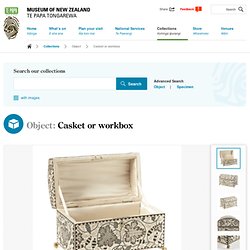
Please follow the Buy or license link under each image to apply to use this image. (Charges may apply) Why you need to apply for the use of this image Rights for this work may be: controlled by the artist, the artist's estate, or other rights holders; or unclear - Te Papa will do a more detailed analysis of the work’s rights history; or covered by Te Papa’s Mana Taonga principle which supports the rights of holders of traditional knowledge to determine how the image may be used. You need to make sure you don’t infringe on the rights of third parties before you use this image.
More information about copyright We recommend these resources for more information: Find more information about Te Papa's rights project on our blog, including how rights types are assigned. Get in touch Please contact copyright@tepapa.govt.nz. A 17th Century needlework casket, Needlework casket. A Rare South German Miniature Casket (Mankästche) Casket. Sewing was an important skill for a woman in the 17th century and was taught to girls of all classes from an early age.
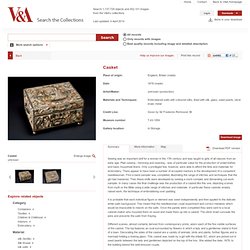
Plain sewing - hemming and seaming - was of particular value for the production of underclothes and basic household linens. Only a privileged few, however, were able to afford the time and materials for embroidery. There appear to have been a number of accepted markers in the development of a competent needlewoman. First a band sampler was completed, illustrating the range of stitches and techniques that the girl had mastered.
Then these skills were developed by sewing a more complex and demanding cut-work sampler. It is probable that each individual figure or element was sewn independently and then applied to the delicate white satin background. Different scenes, almost certainly derived from contemporary prints, adorn each of the five visible surfaces of the casket. Physical description. National Trust Images. National Trust Images Home Features Photographers News Register or Login Filter search Browse categories. Untitled. BPI1700: Database Browser. Untitled. Untitled. Untitled. Untitled. National Trust Collections. Close-up view of the stumpwork mirror frame in the Great Parlour at Lytes Cary.